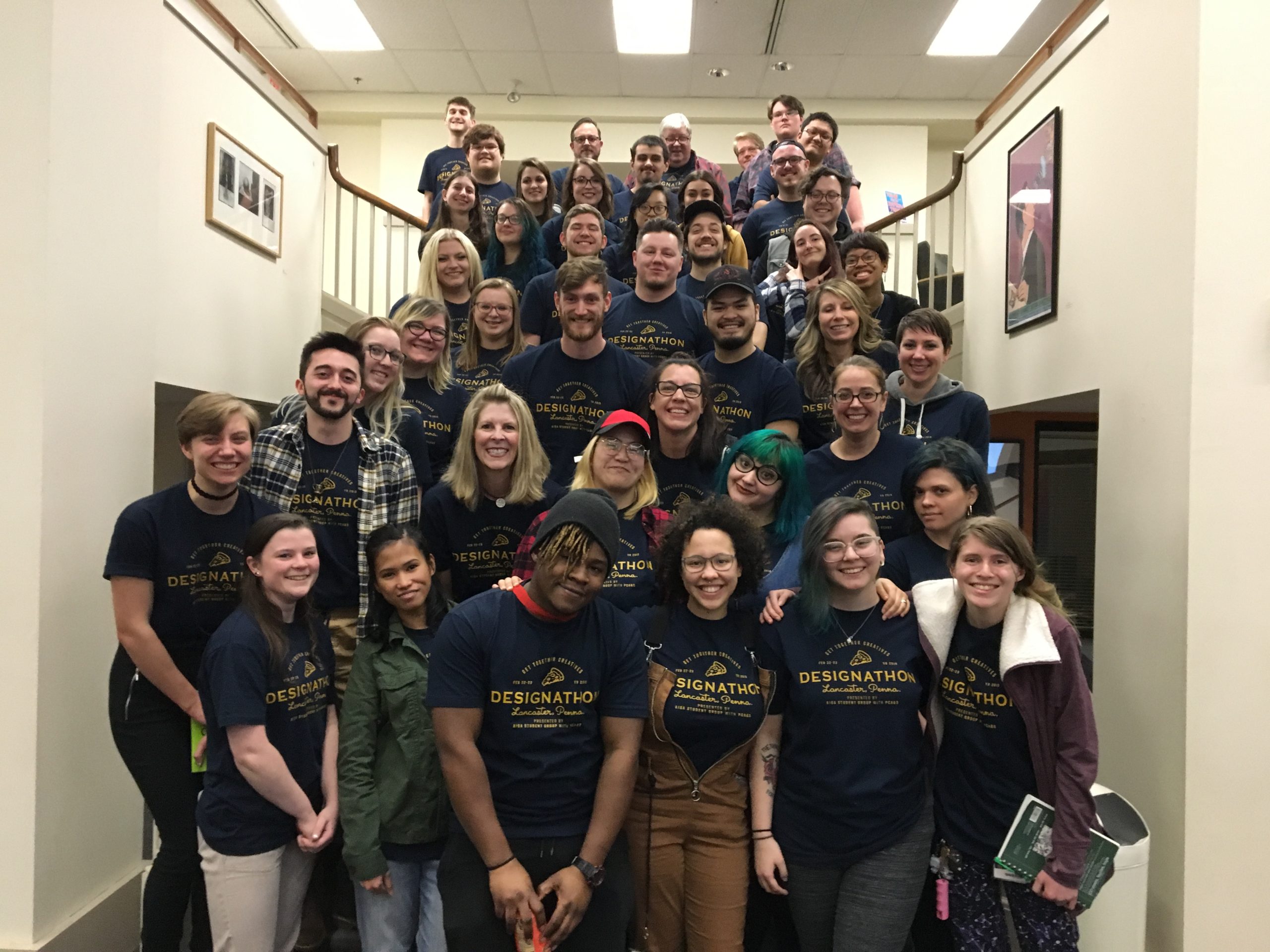
Designathon’s 24-hour marketing blitz is an ultimate College-community partnership
Wednesday, January 22nd, 2020
If you’re passing by PCA&D on the evening of Feb. 22, you’ll spot several dozen students, faculty members, and alumni emerging into the dusk. They’ll be bleary-eyed, maybe even a little over-caffeinated, and they’ll have have earned every minute of their upcoming spring break naps.
They’re Designathon veterans. Each year, in a 24-hour push of brainstorming, designing, refining, production, and presentations, PCA&D students and faculty create free marketing materials — logos, websites, brochures, flyers, whatever’s needed — for local nonprofits.
The client organizations specify what they’d like to have. Design student teams ask questions, prioritize, and gather info. And, then, between Friday night and Saturday night, College classrooms are humming with students busy creating brand-new marketing campaigns from scratch.
“Students ‘get it,'” says Graphic Design Chair Pamela Barby, Designathon’s organizer. “They see the power of art and design — how impactful what they do can be.”

A crucial step during Designathon is meeting with community clients to assess their needs.
All hands on deck
Nonprofit organizations already have a lot on their plate:
Often long on responsibilities and short on resources, new fundraising materials, brochures, and logos often get bumped down the priority list. If it’s a choice between immediate needs and longer-term marketing needs, marketing might stay on the wish list forever.
That’s where PCA&D’s 24-hour Designathon makes a real difference.
Interested in applying for the 2020 Designathon, to be held Feb. 21-22, or learning more? Click here.
An annual event spearheaded by student members of AIGA, the professional association for design, Designathon traditionally has been staffed by Graphic Design majors. And from the very first event 12 years ago, Barby says that everyone on the Graphic Design faculty team has signed on. Now, she adds, students from other majors have started to come on board, too.
“We’re all artists and creatives; we all have ideas,” says Barby. “We’re working on a team and, for the younger students, they may be seeing the entire process for the first time, that process of not creating for yourself, but for a client, from concept to production.”

A checklist keeps everyone on task.
It’s that process, of everyone on the team playing to their strength — while still having a say in the overall process — that makes students willing to sign on for the 24-hour marathon of creativity and problem-solving. And a single Designathon experience often isn’t enough.
This year a number of alumni, from 2019 graduates all the way back to those from the very first Designathon, will return to share their expertise with teams made of current PCA&D students.

Designathon tackles projects for all types of community groups — the main requirement is that they be nonprofit organizations.
The final 2020 client lineup hasn’t been determined yet; organizations that are interested in signing up for the evaluation and redesign process have until the deadline of Jan. 31 to apply. Over the years, Designathon teams have created marketing materials for private schools, recreation centers, counseling centers, anti-hunger initiatives, environmental groups, mental health efforts, and more. And those materials have had an impact — being used, as one example, in presentations to officials in Washington, D.C.

Chair of Illustration Christina Hess takes a break with 2018 Designathon participants. Welcome breaks for food and games help keep creativity bubbling for the whole 24 hours. (photo courtesy Pamela Barby)
Loyalty to the cause
Staying awake for 24 hours straight isn’t easy even if you’re a college student. Remaining creative and alert for that entire timespan is even harder.
“By about hour 18, your brain starts to just not work right,” Barby laughs.
So what earns the 24-hour Designathon such loyalty?

Maybe it’s the steady flow of food and snacks provided by the clients. Maybe it’s the activities (Twister, anyone?) designed to shake loose the cobwebs and get some adrenaline flowing.
And maybe it’s that rush of seeing, in person and in real time, the impact what your skills can have on someone else. For example:
“Sometimes, we’re not asked for much. Maybe it’s just a logo,” says Barby. “But then, if that’s all they ask for, the students will (explore) what the potential could be: What could a website look like? What would it look like on a T-shirt? They’ll create a whole mini marketing campaign.”
At the end of the 24 hours, client organizations returned to the College, and their teams formally present the marketing they’ve created.
“And that’s when the clients get emotional,” Barby says. “They can see how impactful (that new design) could be. And then the students get emotional. And (the faculty does) too. It’s pretty amazing to see the result of what they can do under pressure.”
